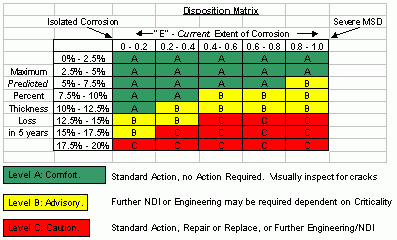The Challenge - Merging technologies such as holistic life assessments, non-destructive inspections, and health monitoring and tracking, APES and their strategic partners can provide customers with comprehensive structural integrity evaluations tailored to unique structural systems and fleets. Improved NDI techniques discover smaller and smaller anomalies in structural systems, often without regard for the maintenance impact of discovering such anomalies. Whether using existing design and maintenanace criteria or establishing improved criteria, CTA and Damage Tolerance Assessments (DTA) using a holistic framework optimize low maintenance cost, fleet readiness, and structural safety.
Engineered Solution - Using holistic life assessment tools to analyze the effects of corrosion pitting, corrosion pillowing, multi-site damage, and thickness loss on fuselage lap splice joints, AP/ES provided NDI threshold detection target values for corrosion thickness loss that would not overly tax the maintenance and repair infrastructure. A new metric was developed to quantify the extent of corrosion on a component, then used with the holistic assessments to ensure compliance with residual strength criteria during multi-site cracking phenomena.


 home
home vision
vision